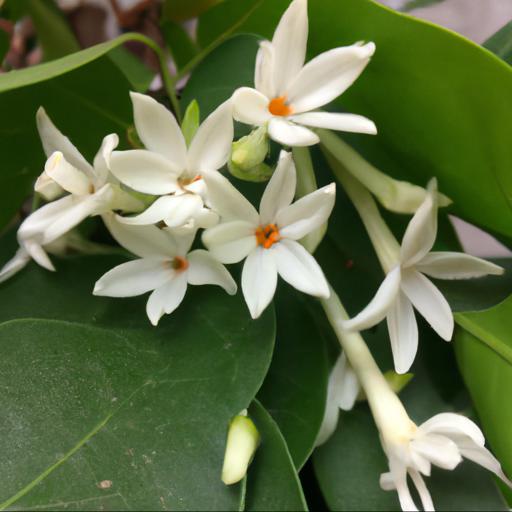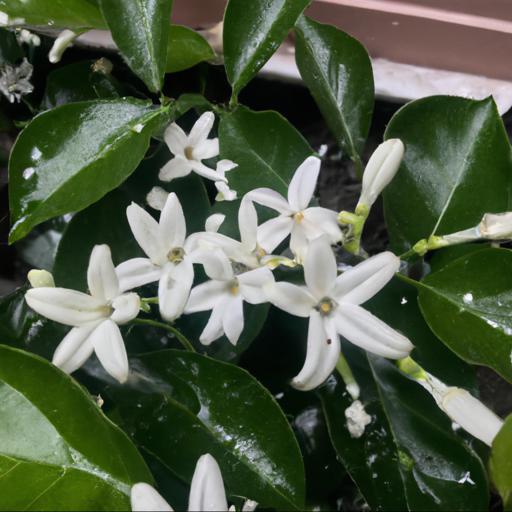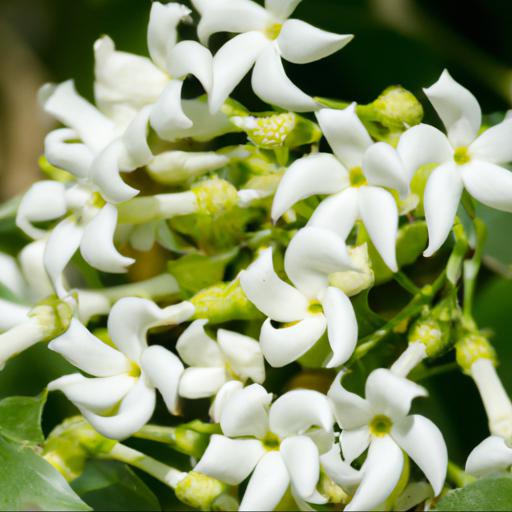Stephanotis floribunda, also known as Madagascar jasmine, is a flowering plant native to Madagascar. It is a popular choice for weddings and other special occasions due to its fragrant, waxy white flowers. This plant is an evergreen climber with glossy green leaves and can grow up to 10 feet tall.
It is a hardy plant and can tolerate a range of growing conditions, making it a great choice for both indoor and outdoor gardens. In this blog, we’ll explore the care and cultivation of Stephanotis floribunda and how to best enjoy its fragrant blooms.
History and origin of stephanotis floribunda

. Stephanotis floribunda, commonly known as Madagascar jasmine, is a woody, evergreen climbing shrub native to Madagascar and parts of Africa.
It’s an incredibly popular flower for weddings and other special occasions due to its star-shaped white petals and pleasing fragrance. As a result, it’s a flower that’s widely grown around the world. The history of this beautiful flower dates back to the mid-nineteenth century, when it was first discovered in Madagascar.
It was first formally described as a species in 1854 by the French botanist Édouard Spach, who named it after the Greek philosopher Stephanos Tourtsiniotis. Stephanotis floribunda rapidly became a popular garden plant in various countries around the world. Today, stephanotis floribunda is widely cultivated and used in wedding bouquets, boutonnieres and other floral arrangements.
Its fragrant white star-shaped flowers make an ideal choice for weddings and other special events. It’s also used medicinally in the many areas where it grows naturally, such as tea infusions or in ointments for skin injuries and boils.
Stephanotis floribunda is an abundant and versatile flower that is sure to bring beauty, joy and fragrance to any special occasion.
Characteristics of stephanotis floribunda

A beautiful and fragrant vine, Stephanotis floribunda (Madagascar jasmine) is widely grown as an ornamental plant. Native to the tropical regions of Northern Madagascar, it is a vigorous climber which can reach heights of up to 10 m given the right conditions and support.
As the name suggests it boasts clusters of creamy-white, sweetly scented flowers that are perfect for adding a special touch to any outdoor area. When grown in warm climates, Stephanotis floribunda is an evergreen which thrives in fertile soils enriched with organic matter. Pruned regularly and supported by sturdy trellis or other structures, the Madagascan jasmine will soon turn any garden into a tranquil oasis with its intensely fragrant blooms.
This consists of a waxy corolla surrounded by a five-lobed and five-petalled star, making the plant an attractive addition to beds or containers. Due to its hardiness, stephanotis floribunda is also suitable for conservatories and greenhouses and makes a stunning houseplant when trained to climb up decorative poles. To achieve best results, it’s wise to keep the generously sized vine in a bright, but partially shaded environment.
It’s a good idea to water the Madagascar jasmine regularly and feed it with a balanced fertilizer to ensure maximum health and blooms. With the proper care, the plant will reward you with its heavenly scented white flowers that never fail to fill the air with breathtaking aroma.
Growing and caring for stephanotis floribunda

Stephanotis floribunda, commonly known as Madagascar jasmine, is a wonderfully fragrant climbing plant that is native to Madagascar and the nearby regions in the Indian Ocean. Growing this plant can be challenging and it requires very specific climatic and cultural conditions for it to thrive.
If you can offer these conditions to your Stephanotis floribunda, then you can grown enchanted and beautiful Madagascar jasmine in your garden. To acquire and care for a Stephanotis floribunda, you must first choose the right container and soil type. When selecting the container, it is important that the drainage holes are on the bottom and that it is slightly larger than the root mass of your newly acquired jasmine.
When selecting the soil, make sure it is a nutrient-rich, well-draining soil, such as a 5-1-1 ratio of perlite, peat moss and compost, or a combination of cactus potting soil and sand. The soil should be lightly moist, but not waterlogged, at all times. Once you’ve chosen your container and soil type, you can begin to care for your Stephanotis floribunda.
The plant requires significant amounts of light, but it should not be exposed to direct sunlight all day. If you keep it indoors, place it in a room with a southern or western-facing window, so it can get partial access to filtered light throughout the day.
Provide at least four to six hours of direct sunlight each day. The plant prefers warm temperatures and will perform best when the temperature is between 65-80°F during the day, and about that same temperature during the night. It’s important to keep a consistent level of humidity for your Stephanotis floribunda; anything between 40-70% is ideal.
Finally, be sure to water your plant regularly. The frequency with which you will need to water your Madagascar jasmine will depend on the size of your pot, the temperature, and the humidity levels.
Water until you see the water start to come out of the drainage holes on the bottom of the pot. Taking the proper steps in caring for your Stephanotis floribunda will ensure its growth and bloom. With the right amount of nutrients and attention, you can enjoy the enchanting aroma of this fragrant flower all season long.
Uses and benefits of stephanotis floribunda
The Stephanotis floribunda is a captivating evergreen climbing shrub that can add a dash of color and fragrance to any garden. Native to Madagascar, this species of evergreen shrub is popular for its fragrant and showy clusters of white, bell-shaped flowers, which have a wonderful sweet scent.
Since its exotic and delicate appearance, Stephanotis floribunda can make any garden look like an oasis of greenery, aroma and style. Gardens featuring the Stephanotis floribunda have a number of benefits. Notable among them is its sheer beauty, with its large, glossy leaves, and its star-shaped, 4-lobed white flowers with bright yellow throats.
The Stephanotis floribunda is perfect for those who want to make their garden look stunningly unique. Moreover, it is also suitable for areas with high humidity, making it a very low-maintenance species. In addition, the Stephanotis floribunda offers an abundance of pleasant aromas.
Its sweet, white bell-like flowers have a dainty, refreshing scent that is further intensified by warm summer days. Its exquisite fragrance has been well-noted by gardeners and enthusiasts alike, which makes the Stephanotis floribunda an obvious addition to any garden aspiring for aromatic luxury.
These blooms also bear fruits after the flowering season. The fruits are small, green seed-pods, which can be harvested and used as an excellent source of natural fertilizer.
This natural fertilizer can be used to nourish and replenish the soil, making it ideal for other essential plants. The Stephanotis floribunda is a wonderful addition to any garden, with its beauty, low maintenance needs and sheer aromatic grace. This spectacular evergreen shrub can become an integral part of any landscape or garden, with its luxurious looks and wonderful scent, offering a plethora of uses and benefits to every garden.
Conclusion
The Stephanotis floribunda is an evergreen flowering vine native to Madagascar. This fragrant vine produces clusters of white, waxy, star-shaped flowers that are often used in bridal bouquets and other floral arrangements.
It is a popular choice for home gardens due to its hardiness, easy maintenance, and attractive blooms. The Stephanotis floribunda can be grown in a variety of climates and soil types, making it a great choice for any garden.
FAQ
What is the scientific name of Stephanotis floribunda?
The scientific name of Stephanotis floribunda is Marsdenia floribunda.
What is the origin of Stephanotis floribunda?
The origin of Stephanotis floribunda is Madagascar.
What are the common uses of Stephanotis floribunda?
The common uses of Stephanotis floribunda include ornamental purposes, fragrance, and medicinal purposes. It is also used in perfumes, potpourri, and aromatherapy.
How does Stephanotis floribunda grow?
Stephanotis floribunda grows as a climbing evergreen vine, reaching up to 20 feet in length. It has glossy, dark green leaves and fragrant, white, waxy flowers. It prefers a warm, humid environment with plenty of sunlight and regular watering.
What are the ideal conditions for growing Stephanotis floribunda?
The ideal conditions for growing Stephanotis floribunda are warm temperatures (above 65°F/18°C) with high humidity, bright indirect light, and well-draining soil that is kept evenly moist.
What are the common pests and diseases of Stephanotis floribunda?
Common pests and diseases of Stephanotis floribunda include aphids, mealybugs, scale, spider mites, powdery mildew, and root rot.

